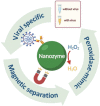Exploration of nanozymes in viral diagnosis and therapy
- PMID: 37324577
- PMCID: PMC10191057
- DOI: 10.1002/EXP.20210086
Exploration of nanozymes in viral diagnosis and therapy
Abstract
Nanozymes are nanomaterials with similar catalytic activities to natural enzymes. Compared with natural enzymes, they have numerous advantages, including higher physiochemical stability, versatility, and suitability for mass production. In the past decade, the synthesis of nanozymes and their catalytic mechanisms have advanced beyond the simple replacement of natural enzymes, allowing for fascinating applications in various fields such as biosensing and disease treatment. In particular, the exploration of nanozymes as powerful toolkits in diagnostic viral testing and antiviral therapy has attracted growing attention. It can address the great challenges faced by current natural enzyme-based viral testing technologies, such as high cost and storage difficulties. Therefore, nanozyme can provide a novel nanozyme-based antiviral therapeutic regime with broader availability and generalizability that are keys to fighting a pandemic such as COVID-19. Herein, we provide a timely review of the state-of-the-art nanozymes regarding their catalytic activities, as well as a focused discussion on recent research into the use of nanozymes in viral testing and therapy. The remaining challenges and future perspectives will also be outlined. Ultimately, this review will inform readers of the current knowledge of nanozymes and inspire more innovative studies to push forward the frontier of this field.
Keywords: antiviral; diagnosis; nanoparticle; nanozyme; treatment.
© 2022 The Authors. Exploration published by Henan University and John Wiley & Sons Australia, Ltd.
Conflict of interest statement
The authors declare no conflict of interest.
Figures








References
-
- Markel U., Essani K. D., Besirlioglu V., Schiffels J., Streit W. R., Schwaneberg U., Chem. Soc. Rev. 2020, 49, 233. - PubMed
-
- a) Berglund G. I., Carlsson G. H., Smith A. T., Szöke H., Henriksen A., Hajdu J., Nature 2002, 417, 463; - PubMed
- b) Eom S. H., Wang J., Steitz T. A., Nature 1996, 382, 278; - PubMed
- c) Martell J. D., Yamagata M., Deerinck T. J., Phan S., Kwa C. G., Ellisman M. H., Sanes J. R., Ting A. Y., Nat. Biotechnol. 2016, 34, 774; - PMC - PubMed
- d) Moss D. W., Clin. Chem. 1992, 38, 2486; - PubMed
- e) Sederoff R., Science 1993, 259, 1521; - PubMed
- f) Wang D., Jana D., Zhao Y., Acc. Chem. Res. 2020, 53, 1389. - PubMed
-
- Zhang R., Yan X., Fan K., Acc. Mater. Res. 2021, 2, 534.
-
- Huang Y., Ren J., Qu X., Chem. Rev. 2019, 119, 4357. - PubMed
Publication types
LinkOut - more resources
Full Text Sources
Miscellaneous
